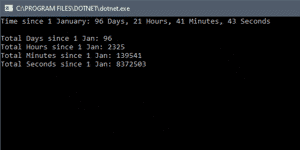Suppose you want to get the number of days between two dates, or the number of seconds between two times. In C#, you can use the DateTime.Subtract method to compute the difference between dates and times.
DateTime.Subtract Method
The DateTime.Subtract method will determine the duration between two dates or times. More specifically, it will return a TimeSpan object which represents the difference between two DateTime objects.
The syntax for using DateTime.Subtract follows:
TimeSpan timeDifference = recentDate.Subtract(oldDate);
In this case, the date represented by oldDate will be subtracted from recentDate and the difference will be stored in the timeDifference variable.
The TimeSpan Object
A TimeSpan object represents an interval between two dates and stores the difference in Days, Hours, Minutes, Seconds, and Milliseconds. Let us consider an example where we are interested in determining the amount of time that has passed between New Years Day and the current instance of time.
DateTime currentDateTime = DateTime.Now;
DateTime newYear = new DateTime(DateTime.Now.Year, 1, 1);
TimeSpan sinceNewYear = currentDateTime.Subtract(newYear);
Console.WriteLine($"Time since 1 January: {sinceNewYear.Days} Days, " +
$"{sinceNewYear.Hours} Hours, {sinceNewYear.Minutes} Minutes, " +
$"{sinceNewYear.Seconds} Seconds");
Console.ReadLine();
On Line 1, I have declared a new DateTime object and initialized it with the current date and time using DateTime.Now.
On Line 2, I created a new DateTime object and assigned it the value of January 1 of the current year. This constructor type takes integer values representing the year, month, and day and saves it as a new DateTime object. For example, DateTime newYear = new DateTime(2019, 1, 1); would initialize a DateTime instance representing January 1, 2019.
On Line 4, I have created a TimeSpan object that represents the time difference between currentDateTime and newYear. This is functionally equivalent to the following:
TimeSpan diff = currentDateTime - newYear;
TimeSpan Properties
The TimeSpan object contains other properties which give the interval as different time units. The TotalDays, TotalHours, TotalMinutes, TotalSeconds, and TotalMilliseconds properties represent the span of time, in each respective unit, as a decimal number.
DateTime currentDateTime = DateTime.Now;
DateTime newYear = new DateTime(DateTime.Now.Year, 1, 1);
TimeSpan sinceNewYear = currentDateTime.Subtract(newYear);
Console.WriteLine($"Time since 1 January: {sinceNewYear.Days} Days, " +
$"{sinceNewYear.Hours} Hours, {sinceNewYear.Minutes} Minutes, " +
$"{sinceNewYear.Seconds} Seconds");
Console.WriteLine();
Console.WriteLine($"Total Days since 1 Jan: {sinceNewYear.TotalDays}");
Console.WriteLine($"Total Hours since 1 Jan: {sinceNewYear.TotalHours}");
Console.WriteLine($"Total Minutes since 1 Jan: {sinceNewYear.TotalMinutes}");
Console.WriteLine($"Total Seconds since 1 Jan: {sinceNewYear.TotalSeconds}");
Console.ReadLine();
On Line 11-14, I accessed various properties of the sinceNewYear TimeSpan object to represent the same time interval in days, hours, minutes, and seconds.
If you are only interested in whole number values, you can use Math.Truncate() to remove the fractional elements.

The Bottom Line
In this tutorial, you learned how to subtract two dates in C#. This technique can be useful for triggering an action after a designated number of days has elapsed. It can also be used to break out of a loop after three seconds. Still have questions about this technique? Let me know in the comments.
Don't stop learning!
There is so much to discover about C#. That's why I am making my favorite tips and tricks available for free. Enter your email address below to become a better .NET developer.
Did you know?

Our beautiful, multi-column C# reference guides contain more than 150 tips and examples to make it even easier to write better code.
Get your cheat sheets